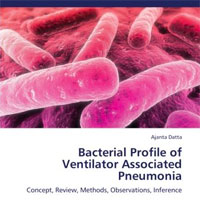Tag: pneumonia
Prediction Model for Severe CAP among Patients with Diabetes Mellitus
Diabetes is an independent risk factor for the development of severe community-acquired pneumonia (CAP) and associated with pneumonia-related hospitalization as well as mortality. Here, we assessed several selected biomarkers... read more
How can artificial intelligence transform pneumonia diagnosis?
Hot on the heels of FDA approval for its AI-guided cardiac ultrasound software, Caption has received a $4.95m grant from the Gates Foundation to create a version that could speed up pneumonia diagnosis, the leading killer... read more
Janssen Investigational COVID-19 Vaccine
An investigational COVID-19 vaccine developed by Janssen Pharmaceuticals appears to be safe and effective at preventing moderate and severe COVID-19 in adults, according to an interim analysis of Phase 3 clinical data conducted... read more
Bacterial Superinfection Pneumonia in COVID-19 Respiratory Failure
Severe community-acquired pneumonia secondary to SARS-CoV-2 is a leading cause of death. Current guidelines recommend patients with SARS-CoV-2 pneumonia receive empirical antibiotic therapy for suspected bacterial superinfection,... read more
COVID-19 Pneumonia: Typical or Atypical Form of ARDS?
Evidence-based guidelines can never help a doctor resolve whether a patient is best managed by inserting an endotracheal tube or avoiding its use. That decision is based on clinical judgment, gestalt, and tacit knowledge.... read more
Circuits Between Infected Macrophages and T Cells in COVID-19 Pneumonia
Some patients infected with Severe Acute Respiratory Syndrome Coronavirus-2 (SARS-CoV-2) develop severe pneumonia and the acute respiratory distress syndrome (ARDS). Distinct clinical features in these patients have led... read more
Why COVID-19 Pneumonia is More Deadly than Typical Pneumonia
Bacteria or viruses like influenza that cause pneumonia can spread across large regions of the lung within hours. In the modern intensive care unit, these bacteria or viruses are usually controlled either by antibiotics or... read more
Time-Controlled Adaptive Ventilation Versus Volume-Controlled Ventilation in Experimental Pneumonia
In the model of pneumonia used herein, at the same tidal volume and mean airway pressure, time-controlled adaptive ventilation, compared with volume-controlled ventilation, was associated with less lung damage and bacteremia... read more
Increasing suction pressure during endotracheal suctioning increases the volume of suctioned secretions
It may be assumed that 250 mmHg suction pressure, via compliance with open system suction method related procedures, is being more effective and equally safe for secretion cleaning in comparison to the 80 and 150 mmHg suction... read more
Endotracheal intubation to reduce aspiration events in acutely comatose patients
Whether intubation results in a reduction in the incidence of aspiration events and whether these are more frequent in patients with low GCS scores are not yet established. The paucity of evidence on this topic makes clinical... read more
Experience Caring for a Severe COVID-19 Patient With ARDS in the ICU
The author's experience caring for a patient with COVID-19 whose condition deteriorated rapidly into a critical illness in the negative pressure room of the ICU is described in this article. The onset of severe acute... read more
COVID-19 and ARDS: The Baby Lung Size Matters
COVID-19 in its initial manifestations has strikingly peculiar characteristics (e.g., hypoxemia with vasocentric injury and high gas lung volume), is so evident that atypical ARDS should not be a matter of further discussion.... read more
Mechanical Ventilators for Non-invasive Ventilation
This book analyzes and describes the whole spectrum of technical elements related with non-invasive mechanical ventilators technologies, ventilator modes and complementary technologies for correct interpretation and clinical... read more

Effect of Tocilizumab vs. Standard Care on Clinical Worsening in Patients Hospitalized With COVID-19 Pneumonia
The administration of tocilizumab in patients with COVID-19 pneumonia and a Pao2/Fio2 ratio between 200 and 300 mm Hg did not reduce the risk of clinical worsening. Further blinded, placebo-controlled randomized clinical... read more
Some Signs of Recovery From Severe COVID-19 Lung Damage
In two early studies, researchers said some patients showed signs of healing just weeks after leaving the hospital. Lingering shortness of breath and diminished stamina have dogged many COVID patients whose lungs were... read more
Synthesis and Systematic Review of Reported Neonatal COVID-19 Infections
A number of severe acute respiratory syndrome coronavirus-2 (SARS-CoV-2) infections have been reported in neonates. Here, we aim to clarify the transmission route, clinical features and outcomes of these infections. We present... read more
VTE and COVID-19: Would you like to know more?
Who wouldn't want to know more about a disease that has killed >1 million people to date, worldwide. Who wouldn't want to know more about the thromboembolic risk associated with COVID-19 when we have been told that the VTE... read more
Bacterial Profile of Ventilator Associated Pneumonia: Concept, Review, Methods, Observations, Inference
ICU is a hotbed of infections and measures are taken to prevent these infections. Ventilator associated pneumonia is one of the Intensive Care Unit related infections. This book tells us what ventilator associated pneumonia... read more

Awake Prone Positioning for COVID-19 Hypoxemic Respiratory Failure
Infection with SARS-CoV-2 can result in Coronavirus Disease–19 (COVID-19). While the majority of patients are asymptomatic or have mild disease, approximately 14% develop more severe disease including hypoxemic respiratory... read more
Anaphylatoxin C5a Impairs Phagocytosis by Neutrophils
This study provides new insight into the mechanisms underlying immunocompromise in critical illness and suggests novel avenues for therapy and prevention of nosocomial infection. Critically ill patients are at heightened... read more
POCUS is Having Its Moment
Ultrasound performed at the point of care (POCUS) is having its moment. The COVID-19 pandemic has seemingly caused the acceleration of POCUS acceptance by hospital leaders, and POCUS examinations are increasingly performed... read more
Cardiovascular Phenotypes in Ventilated Patients with COVID-19 ARDS
Approximately two-thirds of patients admitted to the intensive care unit (ICU) for coronavirus disease-19 (COVID-19) pneumonia present with the acute respiratory distress syndrome (ARDS). COVID-19-associated acute cardiac... read more









